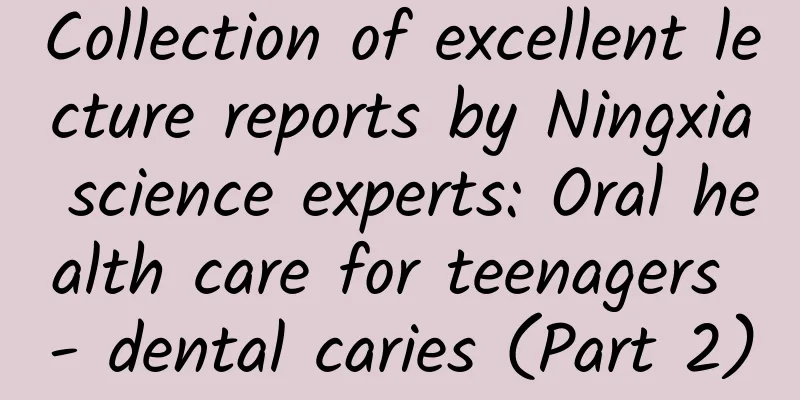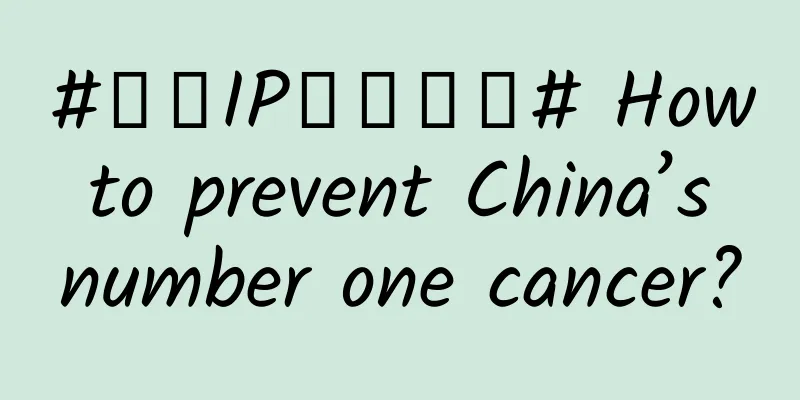Collection of excellent lecture reports by Ningxia science experts: Oral health care for teenagers - dental caries (Part 2)

|
Editor: Kang Yan Reviewer: Yang Pengbin (Speaker: Li Lingling, female, member of the Communist Party of China, deputy director of the Preventive Health Care Department of Yinchuan Stomatological Hospital, propaganda committee member of the Second Party Branch of the Oral Department of Yinchuan Stomatological Hospital, attending physician, young member of the Oral Preventive Medicine Professional Committee of the Chinese Stomatological Association, has studied in the Preventive Health Care Department of Peking University Stomatological Hospital. I am mainly engaged in dental clinics, oral health education and comprehensive prevention and treatment of oral diseases. I have been engaged in oral health education for nearly 10 years, with a total of about 150,000 health education sessions, covering people throughout the life cycle. I am responsible for and participate in many oral public health projects such as: "Ningxia Children's Oral Disease Comprehensive Intervention Project", "FDI", "Ningxia Region Disabled Children's Oral Disease Comprehensive Intervention Project", "Healthy Oral Growth Project", "Western Region Disabled Children Oral Disease Prevention and Treatment Public Welfare Project", etc., and organize oral volunteer activities all year round. Won the honorary title of "Science Popularization Star" in the 2019 National Oral Health Science Popularization Speech Competition-Northwest Region Competition; won the honorary title of "Science Popularization Elite" in the national competition; and obtained the title of "Healthy Oral Promotion Ambassador" awarded by the China Dental Disease Prevention and Control Foundation; guided and planned a total of 7 popular science creations He has used free clinics such as theme days, WeChat public accounts, and news media to promote oral health education to the public. He has assisted the China Dental Disease Prevention and Control Foundation in promoting public welfare oral causes at the Shenzhen Charity Fair and guided the public on scientific toothbrushing methods; he participated in the "21-day Scientific Toothbrushing Training Camp" public welfare activity jointly sponsored by the Beijing Center for Disease Control and Prevention, Beijing Health Education Institute, and the China Dental Disease Prevention and Control Foundation in 2021, and was awarded a volunteer certificate. In the process of diagnosis and treatment in the department, the digital audio-visual education (digital multimedia all-in-one machine) model is implemented, and popular science creation is incorporated into clinical teaching work. Students are encouraged to collect information and create oral science works to improve their oral health education capabilities and tap the potential for creating oral science works. In 2021, he applied for and established the Chinese Stomatological Association's Oral Health Education Innovation and Shining Plan project "Observation on the Effect of IMB Model Combined with Continuous Oral Health Education in Oral Health Education for Pregnant Women" to explore new models for the promotion of oral health education for special populations. ) 3. Gingivitis Periodontal tissue The periodontal tissue is composed of the gums, alveolar bone, and periodontal ligament (the connecting tissue between the gums and alveolar bone), which together form a large family of periodontal tissues. **Gums: ** are the pink gums around the teeth. They are slightly elastic and can withstand the pressure of chewing and the friction of food. **Alveolar bone: **It is the bone tissue surrounding the tooth roots. The soil around a tree supports the stability of the tree. The alveolar bone is like the soil around the tooth roots, maintaining the stability of the teeth. So the periodontal tissue supports our teeth just like soil. Once the soil is eroded, the trees will fall down. When the periodontal tissue is destroyed, our teeth will become loose and may eventually be lost. Factors causing periodontal disease There are many factors that cause periodontal disease. The main culprit of periodontal disease is dental plaque. Dental plaque in the mouth causes inflammation of periodontal tissues and causes periodontal disease. Tartar and food impaction can aggravate periodontal disease. How do we know if we have periodontal disease? How do you know if you have periodontal disease? If you notice bleeding gums, red and swollen gums, loose and dislocated teeth, or bad breath, you may have periodontal disease. The most common symptom of periodontal disease is bleeding when brushing teeth or eating. When the disease is more serious, bleeding may occur even when the gums are not touched. Many parents think that this is a sign of inflammation and do not pay attention to it. When the disease progresses further, the gums will become red and swollen, and the teeth will become loose and shifted. Do students bleed when brushing their teeth? Students are now in adolescence. Due to the increase in sex hormone secretion, our bodies are more sensitive to the stimulation of bacteria and toxins. The most common periodontal disease is gingivitis, also known as adolescent gingivitis. Poor oral hygiene, plaque and tartar accumulation, gum inflammation, redness, swelling, and bleeding. If we control oral hygiene at this time, after periodontal treatment by a dentist, the condition can be reversed and the periodontal tissue can return to normal. 4. Dental trauma and malocclusion Tooth trauma Another common oral disease for students of this age is tooth trauma. Have any of you ever had a tooth trauma? Where was it injured? How did it happen? If it was injured, was the tooth loose or did the gums bleed? How did you deal with your tooth injury? Let's take a look. Causes of dental trauma So under what circumstances do dental trauma usually occur? 1. If students accidentally fall or collide during activities, dental trauma is likely to occur. 2. Sports, especially dangerous sports such as basketball, football, roller skating, etc. 3. Violence. 4. Traffic accidents: including accidents involving cars, motorcycles, bicycles, etc. 5. Others: including knocking teeth while eating, opening wine bottle caps with teeth, biting hard objects, etc. So what harm does dental trauma do to our lives? Obviously, it doesn’t look good, because the front teeth are the most vulnerable, which affects the appearance. In addition, if the teeth fall out or half of them are knocked off, it will affect our pronunciation and eating. What should we do after dental trauma? Emergency treatment for complete tooth dislocation If the tooth is completely dislocated, it should be put back in place immediately. When we pick up a tooth with our hands, we should hold the crown and avoid touching the root. If the tooth is dirty, rinse it with saline or tap water for about 10 seconds. Put the tooth back into the alveolar bone of the tooth as much as possible. If it cannot be put back in place, put it in milk or keep it in your mouth. See a dentist as soon as possible. It is best to arrive within 20 minutes, and the longest time should not exceed 2 hours. Dental trauma precautions What should we pay attention to after dental trauma? What should we pay attention to when eating? First of all, eat soft food and be careful not to chew hard things, which will aggravate the damage to your teeth. Secondly, pay attention to maintaining oral hygiene and brush your teeth with a soft-bristled toothbrush after meals; you can also rinse your mouth with mouthwash or salt water twice a day. Finally, we should also have regular follow-up visits so that the doctor can understand the changes in the affected teeth in a timely manner and adjust the treatment plan to achieve the best treatment effect. Malocclusion Now that we have discussed dental trauma, let's look at these pictures. Do any of you have teeth like this? Do you think these teeth are pretty? This is the fourth common oral disease among teenagers - malocclusion. The dangers of malocclusion One of the major hazards of malocclusion is that it affects the appearance, which will make many students feel inferior, and then cause some psychological problems. In addition, malocclusion also affects oral function, making the teeth unable to fully play the chewing function, leading to poor nutrient absorption and other diseases. Moreover, if the teeth are not straight, our brushing efficiency will be reduced. If we always fail to brush our teeth clean, it is easy to cause some dental diseases, such as caries and periodontal disease, which will affect oral health. Therefore, malocclusion should not be underestimated. Prevention of malocclusion Since malocclusion has so many harmful effects, how can students prevent it? We should consciously prevent and treat dental caries. We should also pay attention to the dental caries of deciduous teeth. If there are missing teeth, we should go to the hospital in time to keep the dentition intact. In addition, bad oral habits should be eliminated as soon as possible, and eat more coarse grains or foods containing crude fiber. Treatment of malocclusion When malocclusion occurs, we must go to the hospital for treatment. So when should we go for treatment? Treatment timing: Generally, students with malocclusion are treated at around 12 years old, but orthodontic treatment is possible for all ages, and there is no strict age limit. For severe malocclusion, treatment should be started as soon as possible. Regular follow-up examinations are required for early detection and early treatment. 5. Tips for Oral Health Care for Teenagers Well, now that we have talked about common oral diseases, let’s talk about how to protect our teeth. Students, do you know any methods to protect your teeth? Foods that are good for dental health First of all, we must choose food reasonably. It is recommended that you eat more fresh vegetables, fruits, eggs, milk, etc. They are high in vitamins and proteins, low in sugar, and contain crude fiber, which is very beneficial to the health of teeth and the body. Foods that are bad for your dental health Carbonated drinks, cakes, ice cream, sugar, chocolate, etc., although these foods are sweet and delicious, they are extremely harmful to teeth. They are easy to adhere to the surface of teeth, which can easily cause bacteria in the mouth to multiply and thus damage teeth. It is recommended that students eat less of them. Rinse your mouth after eating We should develop a good habit of rinsing our mouths after meals. Rinsing our mouths after meals can reduce the acidity in the mouth and reduce the risk of tooth demineralization and caries. Rinsing your mouth after drinking tea or colored drinks can effectively prevent pigments from depositing on the tooth surface. Control the frequency of sugar intake Controlling the frequency of sugar intake is more important than controlling the amount of sugar intake. Sugary foods are best consumed during or after meals, and should not be eaten multiple times between meals. Also, you should eat less sticky sugary foods. Brush your teeth after eating sugary foods to reduce the time the sugar stays on the tooth surface. Another thing to remember: don't eat sweets before going to bed at night, and don't drink sweetened milk or beverages, because the bacteria on the surface of the teeth are most active when people are asleep. Here are some tips to prevent tooth decay: Avoid eating too much sugar. Reduce the frequency of sugar intake and shorten the time sugar stays in the mouth. Eat sugar at the same time as meals, and avoid sweets before going to bed or after brushing your teeth. After eating sweets, you can reduce the damage of sugar to your teeth by brushing your teeth, drinking boiled water or gargling your mouth. Use a sugar substitute - xylitol. How to brush your teeth effectively? The key is to be comprehensive Effective brushing can clean teeth comprehensively and remove dental plaque on the tooth surface without causing damage to the teeth and surrounding tissues. How do you usually brush your teeth? How many times do you brush your teeth every day? How long do you brush each time? Do you brush horizontally or vertically? Do you brush your tongue? Do you think you have achieved the desired effect by brushing your teeth? Improved BASS brushing method ——Horizontal vibrating brushing method (1) Place the toothbrush bristles at the junction of the gums and teeth, at a 45-degree angle to the tooth surface, and gently apply pressure so that the end of the bristles enters the gingival sulcus. (2) Brush 2 to 3 teeth in a group. Vibrate horizontally for about 10 times at a short distance, then brush again and move to the next group of teeth. (3) Place the toothbrush head vertically on the inner side of the upper and lower front teeth, and use the brush head to touch the tooth surface at the gum line, vibrating up and down. (4) When brushing the occlusal surface, point the bristles toward the occlusal surface and brush back and forth over a short distance with slight force. (5) When brushing the back of the last tooth, hold the brush head upright and brush from the lingual surface of the last tooth along the gum margin to the back of the tooth to the buccal surface. (6) Brush your tongue at the end. Lick your teeth after brushing. If the surface of your teeth is smooth, it means that your teeth are clean. Tips for brushing your teeth 1. Be comprehensive: Brushing your teeth should be done in a certain order, with some overlap between tooth surfaces so that every part is brushed clean without missing any. 2. Areas that are easily overlooked: the lingual side of the lower teeth and the back of the last molar. These areas are difficult to reach when brushing your teeth, so special attention should be paid to avoid missing them. The back of the last molar can also be cleaned with dental floss. 3. Time: Make sure to brush your teeth at least twice a day, and clean your teeth before going to bed at night. Because we have eaten a day's food, there are a lot of food residues left in the mouth. Of course, we cannot sleep with these dirty things. Clean again after getting up in the morning to keep the mouth clean. It takes at least 2 minutes each time to clean each tooth. Note: 1. Avoid brushing horizontally with force, as it can cause gum recession and tooth neck defects, which can damage our teeth and gums. 2. Bristles that are turned outward/inverted should be replaced at any time. Toothbrushes should be replaced at least once every three months. This is because after a period of use, the bristles will turn outward and cannot clean the teeth thoroughly. In addition, more bacteria will remain on the bristles. 3. After brushing your teeth, you should place the toothbrush with the bristles facing upwards in a mouthwash cup. This will keep the toothbrush head ventilated and prevent bacteria from growing. Dental floss Although brushing can effectively clean the plaque and soft scale on the surface of our teeth, the gaps between teeth are called interdental spaces, which are the most likely to retain plaque and soft scale. It is difficult for the bristles of the toothbrush to reach the interdental spaces when brushing. Dental floss can effectively remove the residue and plaque in the interdental spaces. Therefore, we should treat dental flossing and brushing as equally important. How to floss (1) Take a 20 cm piece of thread and wrap the ends around the middle fingers of both hands, leaving 5 to 7 cm between the two fingers. (2) Use your thumb and index finger to hold the dental floss tightly together, leaving a 2 cm width in the middle. (3) Place the dental floss between the teeth and slide it gently back and forth until it passes through the contact between the teeth and enters below the gum line. (4) The neck is close to the tooth surface on one side and wraps around the tooth surface in a "C" shape. (5) Scrape away plaque from the gums toward the crowns, repeating 3 to 4 times on each tooth surface. (6) Wrap the dental floss around the other tooth surface in the interdental space and repeat the scraping action. Repeat the above steps to clean the tooth surface of the next tooth, and complete the cleaning of all teeth in sequence. 1. Dental floss is very thin and it will not make the gaps between teeth bigger. 2. If you use the dental floss correctly and find blood on it, it means that your gums may be inflamed. Topical application of fluoride In addition to proper diet, brushing teeth and using dental floss, what other methods can be used to protect teeth? Fluoride can enhance the resistance of tooth enamel and inhibit the growth of bacteria that cause dental caries in the mouth. Appropriate use of fluoride can effectively prevent dental caries. This is like putting on a piece of armor for teeth to resist external adverse stimuli. The main methods include brushing teeth with fluoride toothpaste on a daily basis and receiving professional fluoride application in the hospital. Fluoride toothpaste Scientists have discovered that fluoride can enhance teeth's ability to resist caries and effectively prevent caries. Fluoride coating Fluoride coating is done by doctors in professional medical institutions to help us prevent dental caries. Every six months to a year, we can go to the hospital to apply fluoride to enhance the acid resistance of teeth and protect them. Pit and fissure sealing The chewing surface of molars, which is the surface of the teeth used for chewing food, is uneven, and the sunken areas are called pits and fissures. If these pits and fissures are not well developed, they are very deep, and food and bacteria are embedded in them, which can easily cause caries. About 90% of caries start from pit and fissure caries. Pit and fissure sealing uses polymer materials to seal these gaps, making the bottom of the pits and fissures flat and easy to clean, which can effectively prevent caries. Pit and fissure sealing of permanent molars can be performed at the age of 6-7 and 11-13. Students, have you done pit and fissure sealing? The process of pit and fissure sealing The process of sealing is just like what the pictures show: cleaning, etching, rinsing and drying, applying sealant, curing, and inspection. Regular dental check-ups Regular oral examinations can help you find oral problems in time. Early detection and early treatment can achieve better treatment results, and at the same time prevent some oral problems. Cleansing In addition, during regular checkups, if a professional doctor deems it necessary, periodontal cleaning, that is, teeth cleaning, is also required to prevent periodontal disease. We just mentioned that dental calculus must be removed by teeth cleaning. Scaling is to remove dental plaque, calculus, pigments and other dental deposits on the tooth surface. Prevention of dental trauma Finally, we should also pay attention to preventing dental trauma in daily life. We should strengthen protective measures during sports activities to prevent accidents. We can wear protective mouth guards or helmets when participating in strenuous sports. Protective mouth guards can be made at a dental hospital. Secondly, we should not chase and play in dangerous and narrow places such as stairs and corridors in daily life. Another very important point is that we must fasten our seat belts when riding in a car to reduce the damage in the event of an accident. |
<<: Beijing will conduct a population serum antibody survey, experts explain in detail
Recommend
Can applying olive oil prevent stretch marks?
Stretch marks are a skin problem that many women ...
Every time after sex, it itches
Some female friends find that their lower body be...
Can pregnant women drink Xuanmai Ganju granules?
Xuanmai Ganju granules have the effects of cleari...
Do birth control pills affect pregnancy tests?
Although birth control pills are very effective f...
How many months of pregnancy does vomiting start?
As we all know, after pregnancy, due to the chang...
Why is it "limit salt" instead of "quit salt"?
Author: Cui Yihui, registered dietitian Reviewer:...
What causes wrist pain after childbirth?
Some mothers after childbirth will report that th...
What are the dangers of induced abortion in late pregnancy?
Induced abortion at later stage is a measure to t...
Normal values of human chorionic gonadotropin during pregnancy
Human chorionic villus growth hormone is a glycop...
Too nervous, blood test hcg is inaccurate
Generally, when you go to the hospital for a phys...
Is osteoporosis also "gender-discriminatory"?
This is the 4273rd article of Da Yi Xiao Hu Real ...
Can I drive if I forget to bring my driver's license? What should I do if the windshield fogs up when driving in the rain?
Cars have become the means of transportation for ...
Why does it take 12 days to detect blastocysts?
The embryo was not detected until twelve days lat...
How many days can blastocysts detect pregnancy?
At present, in vitro fertilization has long been ...









